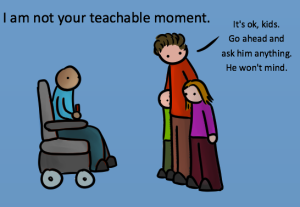
Credit: Molly Nap
Whether it’s watching her favorite Disney show, looking at cute videos of kittens prancing about on YouTube, or spending time on Facebook, your daughter is surrounded by it: media.
And it’s more pervasive than ever before. Studies show that while teens and preteens spend less time watching TV, they spend more time than ever on their cell phones and using social media.
And as a parent (or aunt, sister, or any other caretaker), if you’ve spent time online, watching TV, or basically just being alive, you know that at times the media portrays girls and women in a less than positive light—as sexual objects, as victims, as the lesser half of a romantic relationship.
And unfortunately, these messages start to sink in over time.
Fortunately, however, there are several things you can do to help your daughter navigate this confusing virtual onslaught of messages she receives on a daily basis.
Sexualization
This topic is usually the first to come up when negative media influence on girls is discussed. And to be honest, there’s not a lot that hasn’t already been said about it. (For excellent advice on the subject read Too Sexy, Too Soon from Common Sense Media). However, in all the advice out there on the topic, there are a couple of main points to remember.
What To Do
- Pay attention and talk to her about what she’s seeing. Watch the shows your daughter watches. Read the magazines and books she’s reading. If she has a Facebook page, scroll through her “Likes” and the people she follows to learn more about her interests. If she’s reading something that exploits women and girls for their sexuality, discuss what that means with her.
- Stay positive. On the flip side, don’t be negative. If you discover that she’s a fan of a certain celebrity who dresses sexy, for example, don’t trash-talk that person or say she dresses like a tramp. This will only make your daughter more argumentative and reluctant to absorb what you’re telling her, and worse, it reinforces the negative connotations we’re working to overcome.
Body Image and Dieting
Every time I pick up a women’s magazine, I see a barrage of dieting tips on how to look better: “One-Minute Makeup Refreshes!” “Ten Celebrity-Approved Braids for Back to School!” “How to Lose 10 lbs. in Six Weeks!”And it’s only getting worse. In 1992, the average model wore a size 4 to 6. Today, she’s a size 0 to 2. The unattainable standard of beauty set by the media and fashion world has only gotten more unattainable, and everywhere our daughters look they see examples of this.
How you can help
- Focus on the internal vs. the external. Today, girls younger than ever are internalizing the message that it’s important to be thin. Some reports even say that girls as young 6 years old are dieting! So it’s important to let your daughter know from the start that her most valuable asset isn’t her looks. Emphasize what her body can do vs. its outward appearance. If your daughter plays sports or seems interested in a certain activity, focus on how food fuels her body so that she can perform well while doing those things.
- Provide positive role models. Seek out girls within various forms of media who use their talents or intellect instead of their sexualized bodies to succeed and talk about them with your daughter. For the 10-18 year old girl, Katniss Everdeen in the popular Young Adult series, The Hunger Games, is a prime example—she’s a skilled hunter, she saves her family from starvation, and (spoiler alert!) she battles courageously to overcome obstacles after being thrust into a post-apocalyptic battlefield and forced to fight to the death. Her looks and clothing are rarely mentioned, except when she’s being prepped for the arena, and even then it’s in passing, as in something she doesn’t want to focus on but is being forced to do.
Relationships
In Hollywood and other mediums, women have historically been portrayed as either the damsel in distress or the weak second half to a relationship. Nowhere is this more evident than in Disney films and marketing toward girls. Ariel, Cinderella, Sleeping Beauty—all waiting around to be rescued by the handsome and elusive Prince Charming.
What you can do
- Point out the myth of Prince Charming. It may seem obvious, but make sure your daughter knows that the princess stories and fairytales are exactly that: fantasy. It’s okay that she likes princesses (some of them are pretty cool—check out this ranking of princesses from a feminist perspective), and she most likely will due to their pervasiveness in media, marketing and the like, but it’s important that she realize there will be no prince—or anyone else—coming to rescue her. She’s going to rescue herself.
- Encourage self-development. This is easier to do when girls are younger but seems to become increasingly difficult as girls get older and reach the tween and teen years. In fact, studies show that once girls reach the age of 12, their self-esteem has drastically decreased from when they were younger. Part of this may be due to the role that teen songs and magazines have in pop culture—how to get a boyfriend, why it’s amazing to be part of a couple, or the latest—insecurity is sexy. Basically, it’s the romanticizing of teen romance. Girls should be told and retold that they are amazing people on their own. To paraphrase Cher, having a partner is a luxury, not a necessity.
Quest for Perfection
Every day, our girls are saturated with images of Photoshopped models, beautiful Instagrammed people having a glorious time and fictional women in positions of power that work 24/7 but still somehow manage to look perfect, say the right thing, dress in the latest fashions and be brilliant. And subconsciously or not, these idealized images start to filter into our daughters’ brains, taking hold there and demanding perfection in all they do. And the heavy use of social media has only increased the demand for perfection. A recent study by Common Sense Media found that 28% of girls have edited photos of themselves before posting them online, compared to only 9% of boys.
How to Help
- Call out the falsehoods. If your daughter is young, explain to her what programs like Photoshop can do to alter images and how it is not an accurate representation of girls and women. Discuss how the media will often glamorize characters to draw in readers/viewers and sell a product and how this does not represent real-life people.
- Narrow the focus. If your daughter is older, the demand for perfection may show up in more subtle ways. Notice if she seems to be taking on too many projects, spending too much time getting ready or putting on makeup, or trying overly hard to please people. Remind her that no one is perfect despite what it looks like on TV. Praise her for her talents and try to get her to focus on one or two areas in which to excel so she feels good about herself and stops trying to please everyone.
So voilá! There you have it. Subtle yet effective ways you can discuss media influence with your daughter/niece/sister/or whomever. If our girls are reminded early and often enough, we can combat the negative messages they receive and help them grow into strong, confident women.
What are some ways you support your daughter in developing high self-esteem? Share below in the comments section!
Shannon Ridgway is a Contributing Writer to Everyday Feminism from the great flyover state of South Dakota (the one with the monument of presidential heads). In her free time, Shannon enjoys reading, writing, jamming out to ’80s music and Zumba, and she will go to great lengths to find the perfect enchilada. She dreams of effecting great change in the world by working for a nonprofit agency or an organization that works toward social revolution. In the meantime, she’ll just try to make people laugh. Follow her on Twitter @sridgway1980.
Search our 3000+ articles!
Read our articles about:
Our online racial justice training
Used by hundreds of universities, non-profits, and businesses.
Click to learn more




















